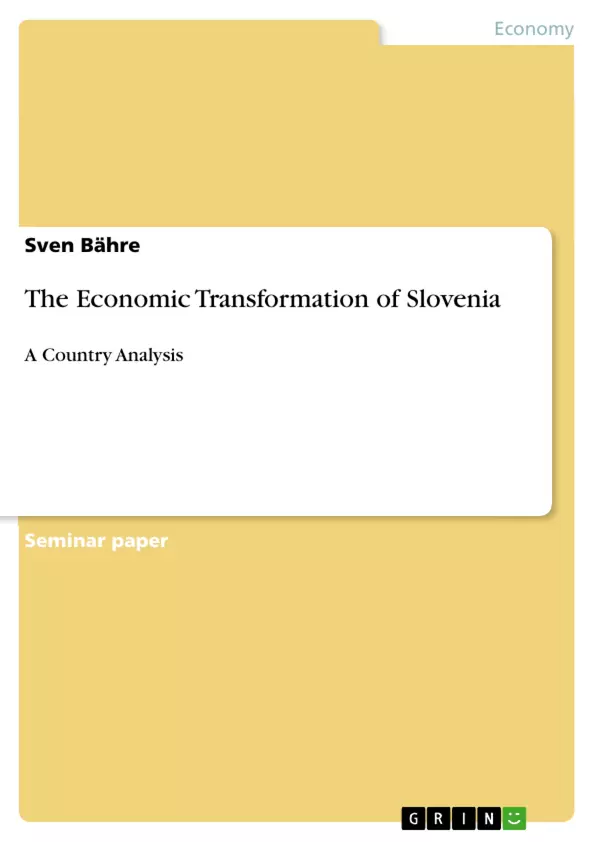Slovenia is one of the best examples for a successful transformation. Founded in 1990, after leaving the communist Federal Republic Yugoslavia, it was one of the first new eastern member states of the EU and the first Eastern-European country which introduced the EURO in 2007. In this paper the transformation process of Slovenia will be analyzed in detail. After a review of Slovenia’s history and its development in Yugoslavia, the initial conditions of the transformation will be described. In the following the transformation process will be dissected. Therefore the political transformation, the liberalization and the market transformation, the privatization and the developments in the financial sector will be portrayed before the entire transformation process will be evaluated. Furthermore the accession to the EU and the EURO zone will be examined, before two current problems, the demographic change and the financial crisis, will be analyzed. At the end of this paper stands a conclusion why Slovenia’s transformation was successful and which parts of it fell short.
Inhaltsverzeichnis (Table of Contents)
- Introduction
- Slovenia's History
- Slovenia's History until World War Two
- Slovenian Performance in Communist Yugoslavia
- Slovenia's Independence
- Transformation Process
- Initial Conditions
- Political Transformation and the Creation of Institutions
- Liberalization and Market Transformation
- Privatization and Development of Enterprises
- Banking and Financial Markets
- Evaluation of the Transformation
- Accession of the EU and the Introduction of the EURO
- Current Problems
- Demographic Change
- Slovenia and the Financial Crisis
- Conclusion
Zielsetzung und Themenschwerpunkte (Objectives and Key Themes)
This paper aims to provide a comprehensive analysis of Slovenia's transformation process, encompassing its historical context, economic development, and current challenges. It explores how Slovenia transitioned from a communist state within Yugoslavia to a successful member of the European Union.
- Slovenia's historical development within the Austrian-Hungarian monarchy and later Yugoslavia
- The political, economic, and social transformations following Slovenia's independence
- Slovenia's accession to the EU and the adoption of the Euro
- The challenges Slovenia faces in the context of demographic change and the global financial crisis
- The factors contributing to Slovenia's success in its transformation process
Zusammenfassung der Kapitel (Chapter Summaries)
- Introduction: Provides an overview of Slovenia's transformation process, highlighting its status as a successful example of economic transition from a communist regime to a market-based economy. It outlines the key themes and topics covered in the paper.
- Slovenia's History: Explores Slovenia's historical development under the Austrian-Hungarian monarchy, its role in Communist Yugoslavia, and its eventual independence. It examines the various political and cultural influences that shaped Slovenia's identity.
- Transformation Process: Discusses the initial conditions for transformation, including the political, economic, and social context. It details the key elements of the transition, including the liberalization of the economy, privatization of state-owned enterprises, and development of financial markets.
- Accession of the EU and the Introduction of the EURO: Examines the process of Slovenia's accession to the European Union and its adoption of the Euro, exploring the economic and political implications of these major milestones.
- Current Problems: Addresses two key challenges facing Slovenia: demographic change and the impact of the global financial crisis. It analyzes the potential consequences and strategies for addressing these issues.
Schlüsselwörter (Keywords)
Key words and topics explored in this paper include: Slovenia, transformation, economic transition, post-communist economy, EU accession, Euro adoption, demographic change, financial crisis, political reform, privatization, market liberalization, banking and finance.
- Citar trabajo
- Sven Bähre (Autor), 2012, The Economic Transformation of Slovenia, Múnich, GRIN Verlag, https://www.grin.com/document/212529



